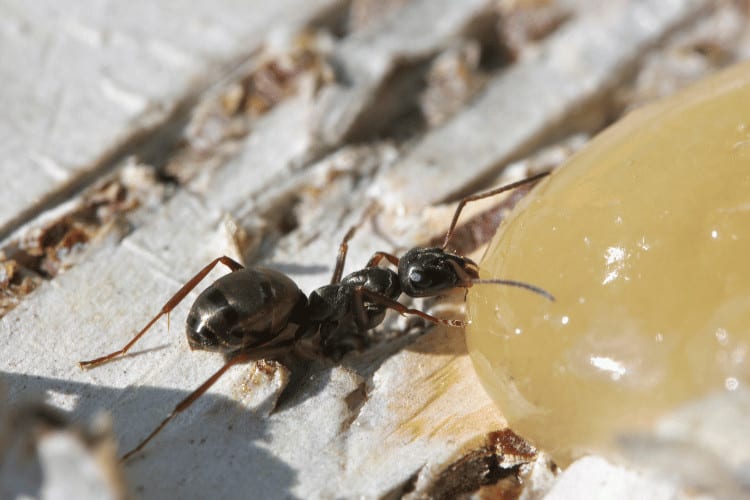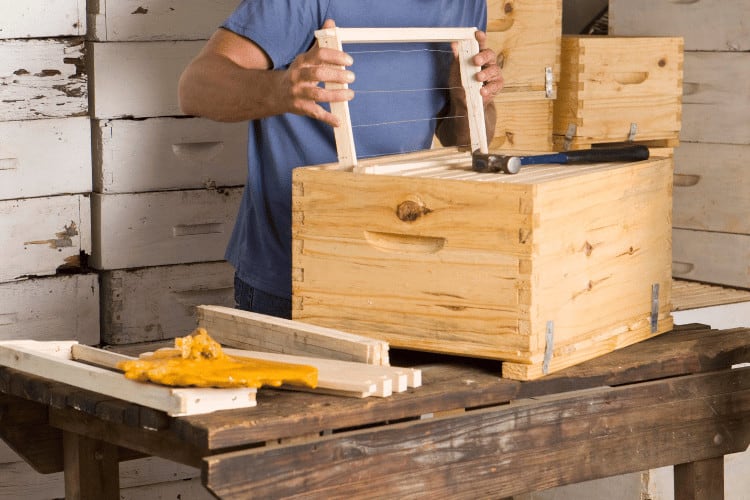Building an Ant-Proof Beehive Stand: A Step-by-Step Guide
Good beekeepers know that beekeeping isn’t just about collecting honey—it’s about creating a safe and thriving home for these amazing pollinators. But there are other players in this beekeeping arena, and they’re not so welcome: ants.
These tiny troublemakers can turn a peaceful beehive into a chaotic battleground. That’s where our hero comes in: the Ant-Proof Beehive Stand! It’s like a fortress for your bee colony, designed to keep those pesky ants at bay.
Whether you’re a seasoned beekeeper or just getting started on your buzzing adventure, understanding how to build and use an ant-proof beehive stand can make a world of difference in the well-being of your hive.
In this article, I’ll break down why those sneaky ants are a buzzkill for your bee colonies, and walk you through each and every step of crafting your very own anti-ant beehive stand.
Ants vs. Bees: Unraveling the Motives Behind Ant Intrusions

Ants’ motivations for targeting bees are rooted in a complex blend of resource competition, opportunistic behavior, and adaptation. According to my research and personal observations, the driving factors their relentless pursuit are as follows:
Resource Competition
Ants don’t mess around when it comes to finding food. Their never-ending quest for grub drives them to raid beehives in search of these culinary delights.
Exploiting the Vulnerable
Ants have evolved to be real opportunists. They’re not shy about going after creatures that are a bit more vulnerable, and that includes certain stages of a bee colony’s life. Those bee eggs and larvae? Ants see them as a top-notch buffet that can fuel their own bustling communities.
Opportunistic Behavior
Ants don’t wait for a formal invitation to the party. When a beehive’s guards are caught napping (or buzzing off elsewhere), ants see their chance and pounce. This sneaky behavior lines up perfectly with Mother Nature’s golden rule: grab whatever resources are up for grabs.
Habitat Overlap
In many cases, ant colonies establish themselves in close proximity to beehives, increasing the likelihood of interactions between the two species. The quest for resources and territorial dominance may drive ants to attack bees.
Tiny Threats, Big Impact: How Ant Attacks Disrupt Honey Bee Colonies
Ants, driven by their survival instincts, exploit the vulnerabilities within bee colonies, disrupting their activities and causing considerable harm.
Understanding the multifaceted impact of ant invasions is crucial for devising effective strategies to safeguard honey bee colonies.
This effort secures the ongoing pollination of your crops and the preservation of these pollinators.
Preying on Eggs and Larvae
Ants are notorious for their opportunistic feeding habits, and honey bee eggs and larvae become easy targets.
Ants raid hives to feed on the developing stages of bees, causing significant mortality rates among the youngest members of the colony.
This not only reduces the number of worker bees that will emerge but also disrupts the brood development cycle, weakening the overall colony strength.
Resource Robbery
Ants are highly skilled scavengers, adept at locating and exploiting sources of food.
In their quest for nectar, pollen, and honey, ants outcompete bees for these essential resources.
Such resource competition can lead to malnutrition among the bees, affecting their ability to produce honey, feed larvae, and sustain themselves through harsh conditions.
Disruption of Hive Activities
Ant invasions create disturbances within the hive environment.
As ants move through the hive, they provoke alarm responses from worker bees, causing unnecessary stress and disrupting the hive’s usual activities.
This disruption can hinder essential tasks such as foraging, grooming, and temperature regulation.
Transmission of Disease
Ants are known carriers of diseases and pathogens that can be detrimental to honey bee health.
When ants invade hives, they can introduce these diseases to the bee colony, leading to increased susceptibility to illnesses and a decline in overall colony health.
Hive Desertion
Persistent ant invasions can push honey bee colonies to the brink.
In some cases, bees might opt for hive desertion (absconding) as a survival strategy, leaving behind valuable resources and brood.
This response reflects the severe stress that ants can impose on bee colonies, as bees prioritize their safety over all else.
Increased Stress and Reduced Productivity
The persistent presence of ants triggers heightened stress levels within bee colonies.
Guard bees that should be protecting the hive from other threats are diverted to combat ant invasions, leaving the hive vulnerable to other predators.
Ongoing stress hinders the overall productivity of the colony, leading to decreased honey production and weaker bees.
Economic Impact on Beekeepers
As a beekeeper, ant invasions translate into increased labor and expenses.
Efforts to manage and mitigate ant incursions require time and resources that you could otherwise devote to nurturing healthy bee colonies.
How to Build a DIY Ant-Proof Beehive Stand
A poor hive, lacking proper defenses against ant invasions, can suffer detrimental consequences that compromise the health and productivity of the bee colony.

Crafting an ant-proof hive stand is a practical and cost-effective solution to ensure your bees’ well-being. Here’s a detailed step-by-step guide to help you build a DIY ant-proof beehive stand:
You’ll Need
- 4 wooden posts (4×4 inches), each about 2-3 feet in length
- 4 wooden boards (2×6 inches), each about 2-3 feet in length
- Galvanized screws or nails
- Mesh or wire cloth (small enough to prevent ant passage)
- Staple gun and staples
- Drill
- Saw
- Level
- Measuring tape
Step 1: Prepare the Posts and Boards
Start by cutting four cinder blocks or any other suitable wood to a uniform height of about two to three feet, depending on your preference and the terrain. These posts will serve as your beehive stand legs.
Follow this by measuring and cutting the wooden boards to match the length of your posts.
These boards will serve as the top surface of your hive stand.
Step 2: Assemble the Base
Select a sturdy base capable of supporting the maximum weight of your hive.
Position the hive legs on the hive base, arranging them in a square or rectangular shape depending on the size of your beehive. Make sure they are evenly spaced and level.
Attach the wooden boards to the tops of the posts using galvanized screws or nails. This creates a stable base for your beehive.
Step 3: Attach the Mesh
Measure the dimensions of the top surface created by the wooden boards. Then, cut the mesh or wire cloth to match these dimensions, leaving a slight overhang to staple to the sides.
Using a staple gun, securely attach the mesh to the sides of the wooden boards, ensuring there are no gaps where ants and hive beetles can enter.
Step 4: Elevate the Beehive Stand
Select a flat surface with a rough texture and ample space to accommodate your beehive stand. Ensure the ground is level and provides adequate stability. Place the ant-proof beehive stand in the chosen location.
Step 5: Place Your Beehive
Lift your beehive carefully onto the ant-proof stand, ensuring it is centered and stable. Make any necessary adjustments to ensure the hive is level.
Step 6: Test for Effectiveness
Observe the hive over several days to ensure ants are unable to access it through the mesh.
Monitor for any ant activity on or near the stand. If ants are still present, consider adjusting the mesh or adding further ant deterrents.
And that’s it—you’ll never lose your hive to ants again!
Regularly inspect and maintain the stand to ensure its structural integrity and continued effectiveness. If you notice any weaknesses or signs of ant penetration, address the issue promptly to protect your bees from ants.
Preventing Future Ant Attacks: Proactive Beekeeping Strategies
While building an ant-proof beehive stand is an effective step in warding off ant invasions, it’s important to recognize that a comprehensive defense strategy involves a multifaceted approach.
Here are some valuable tips to keep ant attacks at bay and ensure the well-being of your precious pollinators:
Maintain a Clean Beehive Environment
Regularly clean the area around your beehive, removing any spilled honey, pollen, or debris that might attract ants. A clean environment minimizes the incentives for ants to invade.

Seal Entrances and Cracks
Conduct routine inspections of your beehive and the surrounding area.
Seal any cracks or openings that ants could use to gain access to the hive. If you need to feed your bees with syrup, ensure that spills are avoided near the hives and surrounding areas.
Implement Natural Deterrents
Consider placing substances with natural ant-repellent properties around the base of your hive stand.
Items like ground cinnamon, cinnamon powder, soapy water, diatomaceous earth, or crushed mint leaves can discourage ants from approaching.
Creating a barrier of grease can also deter ants from accessing beehives. Pans of grease around the beehive’s legs can serve as a natural deterrent, preventing ants from disrupting the bee colony.
Don’t use plain water to deter ants, because while it might create a temporary obstacle, these resourceful insects can often find ways to navigate through or around it.
Monitor and Address Ant Trails
Keep a watchful eye for ant trails near your beehive. Interrupt these trails by removing the ants’ scent markings or by placing ant traps strategically away from the hive.
Utilize Ant Bait Stations
Deploy ant bait stations near the beehive to divert ant traffic away from your bees. These stations can use non-toxic baits that disrupt ant foraging patterns.
Protect Captured Bees
Temporary bait hives can inadvertently attract not only swarms of bees but also opportunistic ants.
As such, it’s crucial to implement preventive strategies that safeguard the captured bees from potential ant invasions and maintain the integrity of the hive.
Securing the hive entrance with barriers, for example, can help prevent ants from sneaking into the hive and causing disruptions.
Regular Inspections
Schedule regular inspections of your hive and stand to ensure they remain in good condition and continue to provide effective ant protection. Be vigilant for any signs of ant activity.
Implement Breeze Blocks
Incorporating a stack of breeze blocks into your hive stand’s design can notably boost its stability and increase the success rate of safeguarding your beehive from potential threats, including the challenges posed by strong winds and wind storms.
Wrapping Up
Crafting a robust anti-ant beehive stand is essential for maintaining the integrity of a commercial hive. By building your own DIY ant-proof beehive stand, you’re taking proactive measures to safeguard your honey bee colonies from the persistent threat of ant invasions.
This cost-effective solution provides your bees with a secure and thriving environment, allowing them to focus on their essential tasks of pollination and honey production.
